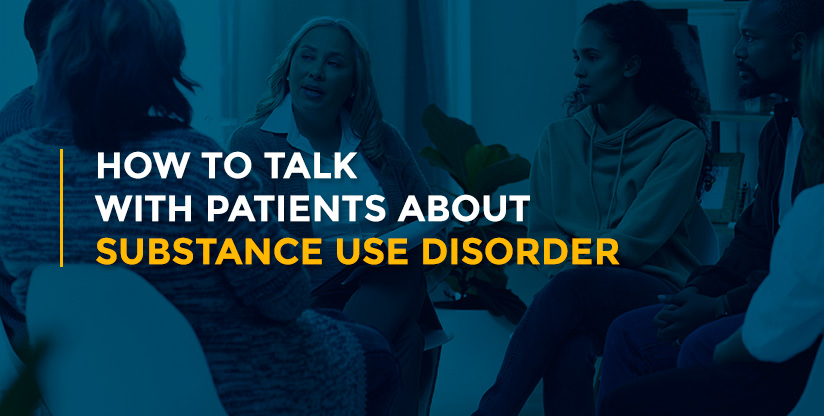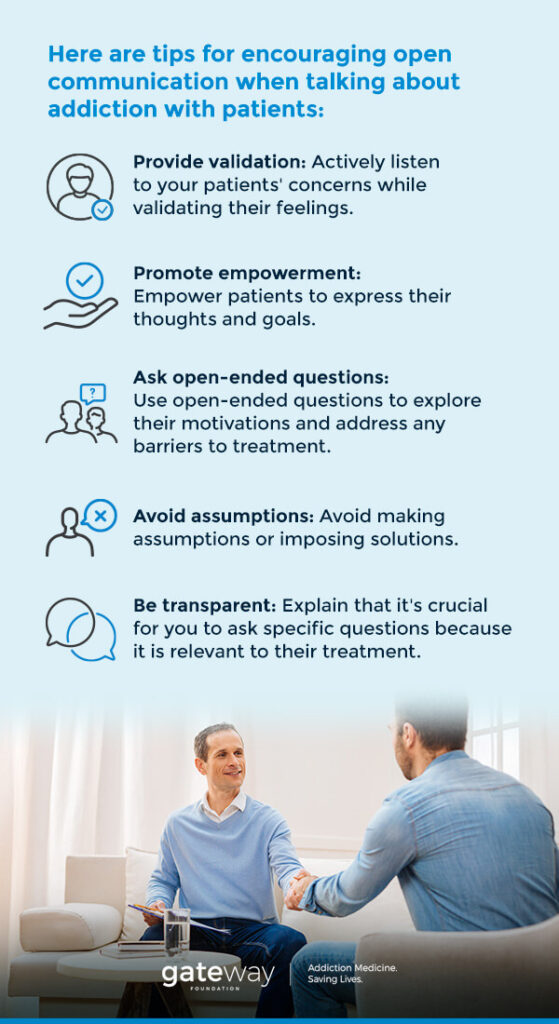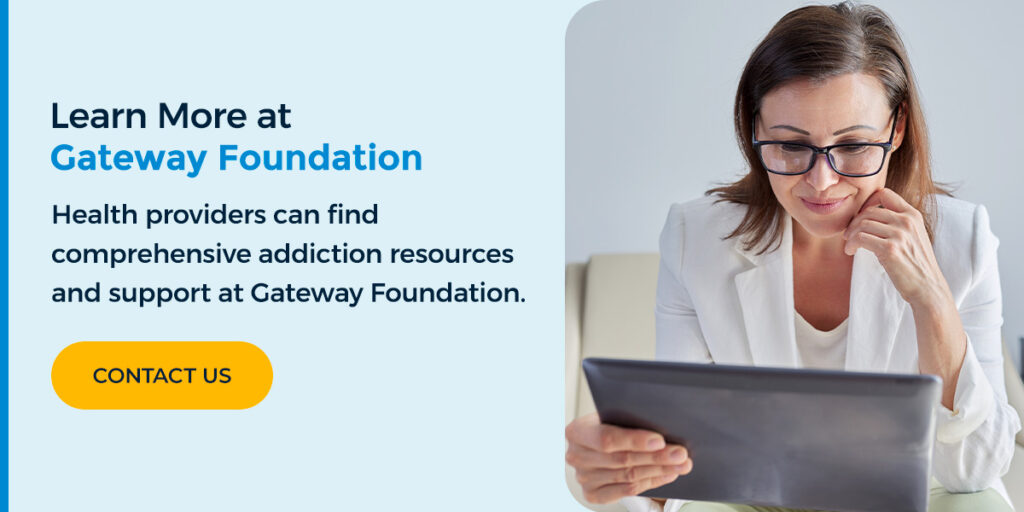When a patient with substance use disorder (SUD) visits, itís essential to talk to them in a way that shows sensitivity and empathy while avoiding stigmatizing language. Psychologists have found [Ö] The post How to Talk With Patients About...

When a patient with substance use disorder (SUD) visits, itís essential to talk to them in a way that shows sensitivity and empathy while avoiding stigmatizing language. Psychologists have found that using medically accurate language can help dismantle stereotypes outside the clinical space while providing more effective, compassionate support for people with addiction. Using motivational interviewing strategies and people-first language can help guide the conversation.†
As a health provider, itís crucial to learn how stigma affects people with addiction and how to create a supportive, compassionate clinical environment for your patients.†
How Stigma Affects People With Addiction
The stigma surrounding people with substance use disorders is a common phenomenon that can significantly impact treatment outcomes, health providers, research, policies, and society.†
Stigma about people with addiction might include inaccurate or unsubstantiated beliefs such as ó they are dangerous, incapable of managing treatment, or at fault for their condition. These stigmas†can have the following detrimental outcomes:
As a clinician, you can show leadership in how language can destigmatize the disease of addiction. Remaining sensitive and nonjudgemental while encouraging open communication with your patients can trickle down into mainstream media and popular culture ó influencing how society views those with addiction and leading to better treatment outcomes.†
11 Tips for Talking With Patients About Substance Use Disorder

Stigma about people with SUD can stem from inaccurate beliefs that addiction is a personal failing instead of what it truthfully is ó a chronic, treatable disease from which people can recover and continue to lead healthy lives. Hereís how you can alter your language to avoid these stigmas and create a safe, supportive environment for patients with addiction:†
1. Use People-First Language
Patient communication in substance use disorders starts with people-first language. Let your patients choose how they are described. That way, you maintain the integrity of your clients as whole human beings rather than equating them to their condition.†
Use terms that have neutral tones and distinguish the patient from their diagnosis. The National Institute on Drug Abuse†recommends using the following words†to reduce stigma when talking about addiction with patients:
Using first-person language can go a long way in promoting empathy in the clinical space that can then extend beyond the medical environment.†
2. Use Medically-Accurate Language†
When talking to your patients with SUD, their family members, and your colleagues, use language that reflects an accurate, science-based understanding of drug addiction. Because clinicians are often the first point of contact for people with SUD, itís essential to take all necessary steps to reduce the potential for negative bias and stigma.†
Accurately diagnosing an SUD is the first step. Familiarize yourself with the Diagnostic and Statistical Manual of Mental Disorders 5th Edition (DSM-5) criteria for SUDs. This ensures you have better knowledge of the specific criteria, allowing for a more practical discussion with the patient about having an SUD. It can also ensure you remain objective, use the correct language and provide proper treatment.
Using medically-accurate language empowers patients to confront their addiction with dignity and receive appropriate care. It can also foster an environment of trust and respect.
3. Ask for Permission
Itís best to start your discussion by letting your patient open up and tell their story. Here are two tips to create a comfortable environment for your patient to speak:†
Seeking permission can help you create a safe, nonjudgmental space, encouraging open communication. Your patient will likely feel more heard and understood, which can foster a stronger therapeutic alliance and increase their likelihood of working with you toward recovery.†
4. Be Aware of Body Language
The words you convey to your patient are only one part of communication ó your body language is also essential to monitor. If you feel a sense of frustration or anger toward a patient and have subtle body cues like changes in eye contact, posture, or tone of voice, they might perceive these as confrontation despite your good intentions.
Pay attention to the following:
Being mindful of your nonverbal cues can foster trust and build a safe space where your patients feel comfortable sharing their experiences and seeking help.†

5. Establish Trust and Show Empathy
Building trust and showing empathy toward patients struggling with addiction is crucial. Here are a few tips to achieve this:
Express to your patient that you intend to connect them to comprehensive services they might need and that recovery is possible.†
6. Acknowledge Struggles and Courage
Acknowledging your patientís struggles and courage is essential to providing compassionate and effective care. By recognizing your patientís challenges, you validate their experiences and efforts in facing the complexities of the disease of drug addiction. Expressing your empathy and understanding shows that you genuinely care and are committed to supporting them on their recovery journey.
Support your patient by recognizing their courage in seeking help and facing their addiction. Youíll demonstrate respect for their resilience, which can encourage them to continue their efforts. It also fosters a positive therapeutic relationship built on trust and mutual respect.
As a health provider, your acknowledgment can be a powerful source of validation and motivation for your patient to overcome obstacles and embrace change. By affirming their bravery and progress, you promote self-empowerment and help them build a stronger foundation for a lasting recovery.†
7. Be Objective
Itís crucial that you objectively share the risks of addiction. Here are a few tips for creating a nonjudgmental space for objective conversation:
Objectivity allows you to respect each patientís autonomy while offering guidance based on scientific knowledge ó ultimately supporting them in making informed choices for their well-being.†
8. Encourage Open Communication†
As a health provider, you must be transparent and encourage open communication when talking to patients with addiction. When you create a judgment-free environment, patients will feel safe sharing their experiences and emotions without fear of stigma. Here are tips for encouraging open communication when talking about addiction with patients:

Being transparent and facilitating open communication demonstrates your commitment to understanding and helping them on their path to recovery.†
9. Normalize the Conversation
Normalizing the conversation can help create a supportive environment and reduce stigma. Acknowledging that addiction is a common and treatable medical condition helps patients feel less isolated and judged. Conveying your empathy and understanding lets you foster an open discussion where patients feel safe sharing their experiences.
Let your patient know that any discomfort they might feel is normal and that they are not alone. For instance, you might say, ďThis is not unusual. Many patients find it hard to talk about their substance use.Ē You might also educate your patient on addictionís biological and psychological aspects to dispel misconceptions about addiction and reduce stigma.
Normalizing the conversation about drug addiction helps break down barriers to seeking help. It encourages your patients to view treatment as a positive step toward well-being rather than a source of shame. Embrace a non-stigmatizing approach, and you can create a therapeutic space where your patients can open up about their struggles and receive the support they need for a lasting recovery.†
10. Promote Collaboration
Promoting collaboration as a health provider helping a patient with addiction is crucial for achieving positive treatment outcomes. Collaboration means working together as a team, valuing your patientís input, and incorporating their perspectives in decision-making. By fostering a collaborative approach, your patients can feel more empowered and respected, enhancing their engagement in the treatment process.†
Collaboration also helps reduce stigma by recognizing addiction for the medical condition that it is. Through collaboration, your patients become active participants in their own recovery, making them more likely to stick to treatment plans and reach better outcomes. Additionally, working together allows for a more holistic understanding of your patientís needs, helping you provide comprehensive and personalized care.†
11. Address Co-Occurring Disorders†
Addressing co-occurring conditions when working with a patient with addiction is crucial for providing comprehensive, effective care. Many individuals with addiction also struggle with underlying mental health issues, and these conditions can often reinforce one another.†
Identifying underlying mental health conditions is also essential for pain management and addiction assessment. Many patients with chronic pain are prone to depression, which can exacerbate pain perception. Helping patients understand the relationship between anxiety and depression and their perception of pain can be therapeutic and help them feel like their provider is invested in their well-being as a person and not just seen as a pain patient.†
Acknowledging and treating co-occurring disorders simultaneously can demonstrate your commitment to holistic healing. The approach breaks down the stigma surrounding mental health, recognizing that addiction and mental health challenges are interconnected and deserve equal attention.†
Learn More at Gateway Foundation
As a health provider, itís crucial that you speak to patients with addiction with compassion, avoiding judgment or biased language. Providing an environment free of stigma can go a long way in their recovery journey and influence other health providers to do the same. Health providers can find comprehensive addiction resources and support at Gateway Foundation. We are a trusted organization with expertise in addiction treatment.†
Our network of specialized facilities offers evidence-based programs for patients seeking help with substance use disorders. Referring patients to Gateway ensures they receive compassionate, personalized care from a team of experts dedicated to helping them achieve lasting recovery. Our holistic approach addresses co-occurring mental health issues, reducing stigma and creating a supportive environment.†
By partnering with Gateway, you can confidently guide patients toward the resources they need for a successful recovery journey. To learn more, contact us today.†
The post How to Talk With Patients About Substance Use Disorder appeared first on Gateway Foundation.



